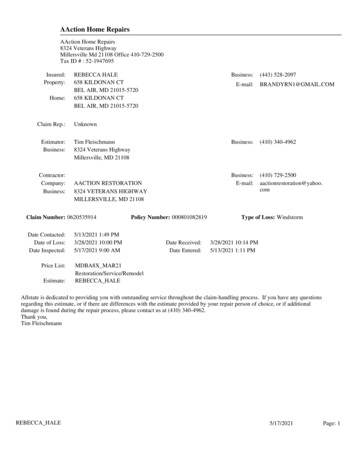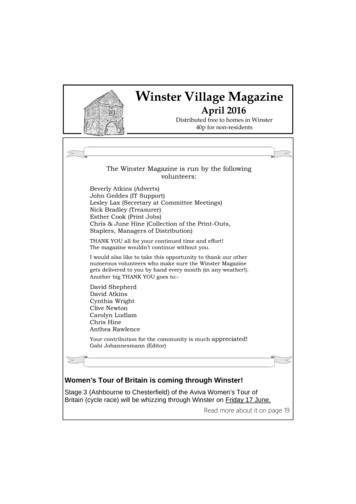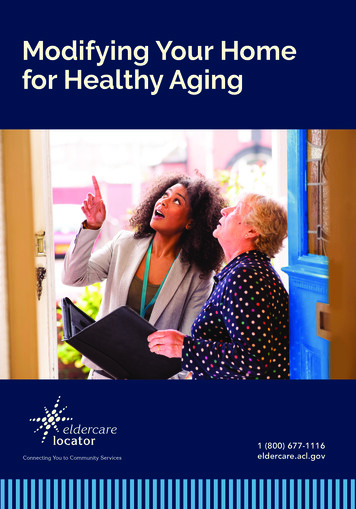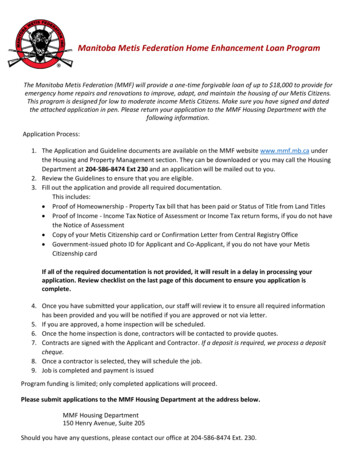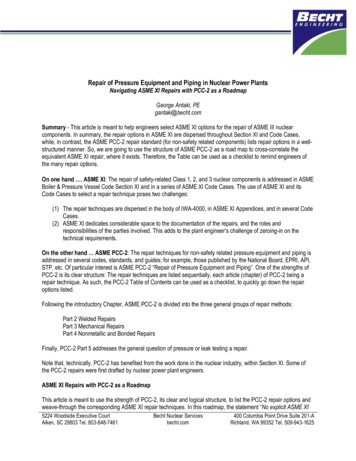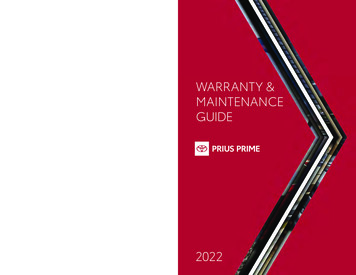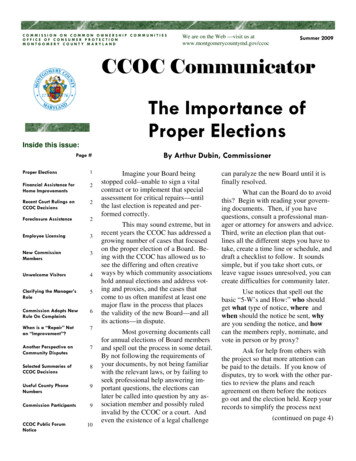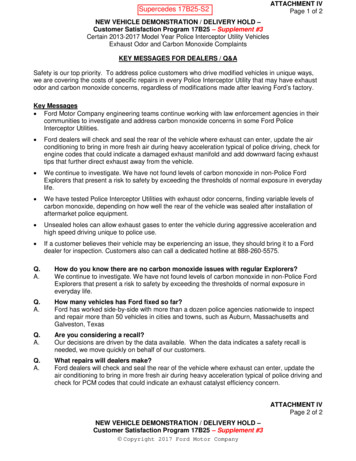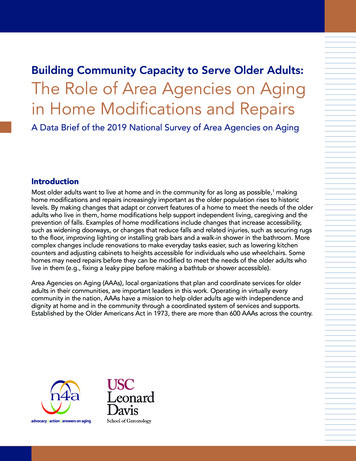
Transcription
Building Community Capacity to Serve Older Adults:The Role of Area Agencies on Agingin Home Modifications and RepairsA Data Brief of the 2019 National Survey of Area Agencies on AgingIntroductionMost older adults want to live at home and in the community for as long as possible,1 makinghome modifications and repairs increasingly important as the older population rises to historiclevels. By making changes that adapt or convert features of a home to meet the needs of the olderadults who live in them, home modifications help support independent living, caregiving and theprevention of falls. Examples of home modifications include changes that increase accessibility,such as widening doorways, or changes that reduce falls and related injuries, such as securing rugsto the floor, improving lighting or installing grab bars and a walk-in shower in the bathroom. Morecomplex changes include renovations to make everyday tasks easier, such as lowering kitchencounters and adjusting cabinets to heights accessible for individuals who use wheelchairs. Somehomes may need repairs before they can be modified to meet the needs of the older adults wholive in them (e.g., fixing a leaky pipe before making a bathtub or shower accessible).Area Agencies on Aging (AAAs), local organizations that plan and coordinate services for olderadults in their communities, are important leaders in this work. Operating in virtually everycommunity in the nation, AAAs have a mission to help older adults age with independence anddignity at home and in the community through a coordinated system of services and supports.Established by the Older Americans Act in 1973, there are more than 600 AAAs across the country.
Information presented in this data brief was gathered through the 2019 National Survey of AreaAgencies on Aging conducted by the National Association of Area Agencies on Aging (n4a) inpartnership with the Scripps Gerontology Center, with funding from the U.S. Administration forCommunity Living (ACL). The survey questions for this data brief were developed in partnershipwith the Fall Prevention Center of Excellence at the University of Southern California Leonard DavisSchool of Gerontology, also with funding from ACL. The response rate of 78.5 percent is based on485 of 618 AAAs responding to the survey, a representative sample.Home Modification and Repair ServicesAAAs are involved in an array of activities related to home modifications and repairs, providingthe services directly or by making referrals to local programs that provide home modifications andrepairs. Sixty-one percent of responding AAAs directly provide or contract with local providers forhome modification and repairs. Forty-six percent of AAAs make referrals to local programs thatmake home modifications or repairs.Figure 1. Home Modification and Repair Services Provided by AAAsAAAs providing home repair and modifica9on servicesWhich of the following services does yourhome modification or repair programn 300deliver and/or coordinate? Check all that apply.Minor home modifica9on installa9on (e.g., grab bars, raisedtoilets, handheld showers, handrails, lever door handles)94%Repairs (e.g., roof, electrical, carpe9ng/floors, loose stairrailings or other stair repairs)56%Major home modifica9on (e.g., remodel bathrooms, adjustcounter/cabinet heights, ramps, elevator/plaMorm or chairliNs, widen doorways, roll-in shower)52%Home assessments (a systema9c review of the homeenvironment)Delivery or coordina9on of otherhome modifica9on or repair services30%10%0% 10% 20% 30% 40% 50% 60% 70% 80% 90% 100%n 300As shown in Figure 1, of the 61 percent of AAAs that provide home modifications directlyor through contracted providers, 94 percent provide minor home modifications, such as theinstallation of grab bars and raised toilets. Fifty-six percent provide repairs, and 52 percent providemajor home modifications, such as remodeling bathrooms and widening doorways.2
Other Activities Related to Home Modification and RepairIn the survey, AAAs were asked about other home modification and repair activities they undertakebesides service provision, such as partnerships or referrals to funding sources that can assistindividuals with affording the cost of home modifications and repairs. Figure 2 shows the mostcommon activities.Figure 2. AAA Involvement in Other HomeModificationor RepairActivitiesOther homemodifica7onac7vi7esn 452Is your AAA involved in other home modification or repair activities?Referrals to direct funding sources forhome modifica7ons or repairs45%Informa7on dissemina7on about homemodifica7on or repair (e.g., fact sheets, presenta7ons)39%Partnerships with voluntary groups to perform home modifica7onsor repairs (e.g., Rebuilding Together, Habitat for Humanity)38%Referrals to or from occupa7onal and/or physical therapists25%Other home modifica7on or repair ac7vi7es2%0%5%10%15%20%25%30%35%40%45%50%n 452Of the 45 percent of AAAs that refer clients to direct funding sources, AAAs most commonly(88 percent) refer individuals to the Weatherization Assistance Program, a program funded bythe U.S. Department of Energy that provides home upgrades for low-income households toimprove energy efficiency and address health and safety concerns. Beyond this, the most commonreferrals to direct funding sources include nonprofit organizations such as Habitat for Humanity orRebuilding Together (62 percent), local city/county housing/community development departments(62 percent) and Medicaid Home and Community-Based Services Waivers (59 percent).3
Reaching a Broad Population with Home Modification and RepairServicesOf the AAAs providing home modification and repair services directly or by contracting withproviders, more than three-quarters (78 percent) serve older adults who have low incomes throughthese programs, and more than half (54 percent) serve older adults living in rural areas. Nearly halfof AAAs in this group serve a diverse clientele that includes caregivers, veterans and older adultsfrom racial or ethnic minority groups. Forty percent of AAAs with home modification and repairprograms serve adults younger than the age of 60 who are living with disabilities (Figure 3).Figure 3. Groups Served by Home Modification and Repair ServicesIn addition to older adults age 60 , do your home modification or repairservices specificallyPopula?onsaddress theneedsof homeany ofthe followinggroups?servedby AAAmodifica?onsservicesOlder adults who have low incomes78%Older adults who live in rural areas54%Caregivers48%Veterans48%Racial or ethnic minority elders46%Adults under the age of 60 with disabili?es40%Other3%0%10%20%30%40%50%n 300460%70%80%90%
Funding Sources for Home Modification and Repair ServicesAAAs were also asked to share which funding sources their agencies use to deliver or coordinatehome modification and repair services. Figure 4 shows the funding sources most commonlyused by AAAs to provide home modification and repair services. As seen in Figure 4, the OlderAmericans Act (OAA) Title III B Supportive Services program is the main source of funding forhome modification and repair services. AAAs rely on this source to also fund many other importantservices, such as transportation, legal services, in-home care and other supportive services, whichlimits the amount that can be dedicated to home modification and repair. In addition to OAATitle III B, AAAs support their home modification and repair services through donations, grants/foundation funds, Centers for Medicare and Medicaid Services (CMS) funding, and cost sharing.Figure 4. Most Common Funding Sources for Home Modification and Repair ProgramsWhich of the following funding sources are used by your AAA to deliver or coordinatethese homeFundingmodificationrepairservices?all that Offeredapply. by AAAs n 300Sources fororHomeModificaTonsandCheckRepair Programs67%OAA Title III B SupporTve Services38%DonaTons (e.g., labor, materials)33%Grants/foundaTon fundsCenters for Medicare and Medicaid Services (e.g., Medicaid Homeand Community-Based Services Waivers)28%23%Cost sharing14%State funding12%Private payOther11%Department of Housing and Urban Development11%8%Department of Agriculture (USDA)/Rural Development5%State housing finance agency0%10%20%30%40%n 300550%60%70%80%
SummaryThe vast majority of older adults want to age at home and in their communities. But, for many ifnot most, the homes they currently reside in will need some degree of modifications or repairs—whether major or minor—to accommodate changing needs and abilities in order to support safeand independent living.AAAs provide home modifications and repairs as part of their mission to support the ability of olderadults to remain in their homes and communities as they age. The 2019 National Survey of AreaAgencies on Aging found that 61 percent of responding AAAs provide home modification or repairservices, and 46 percent make referrals to local programs that make home modifications or repairs.Of the AAAs contracting for or directly providing home modifications and repairs, the most commontype is minor home modification (94 percent) with over half also providing repairs (56 percent) andmajor home modifications (52 percent). Since even minor home modifications have been found tocontribute to quality of life, this effort by 94 percent of AAA home modification and repair serviceproviders is critical.Additionally, core to their mission of developing a coordinated system of services for olderadults in their communities, AAAs often work through partnerships and systems of referrals tomeet needs. The fact that 46 percent of AAAs provide referrals to home modification or repairprograms and that 45 percent refer clients to direct funding sources that can help finance theseservices indicates that AAAs are a go-to local resource for connecting older adults to localprograms that can improve their ability to continue living at home as they age. Since a supportivehome environment has been found to impact health, it is encouraging that over one-quarter ofAAAs are using sources via the Centers of Medicare and Medicaid Services as funding for homemodifications and repairs. Through a range of activities, AAAs connect older adults and theirfamilies to home modifications and repairs, which are key services that support the needs of olderadults living in the tmlNational Association of Area Agencies on Aging1100 New Jersey Avenue, SE, Suite 350, Washington, DC 20003Tel: 202.872.0888www.n4a.org info@n4a.org Facebook & Twitter: @n4aACTIONFall Prevention Center of ExcellenceUniversity of Southern California Leonard Davis School of Gerontology3715 McClintock AvenueLos Angeles, California 90089-0191Tel: 213.740.1364www.homemods.org/acl homemods@usc.eduDevelopment of this report was made possible, in part, by funding from the U.S. Administration for Community Livingunder grant number 90PPUC0001 AND HHS-2018-ACL-AOA-HMOD-0308. The views expressed in this material do notnecessarily reflect the official policies of the U.S. Department of Health and Human Services or represent official U.S.Administration for Community Living policy.
home modification and repair services. Figure 4 shows the funding sources most commonly used by AAAs to provide home modification and repair services. As seen in Figure 4, the Older Americans Act (OAA) Title III B Supportive Services program is the main source of funding for home modification and repair services.

